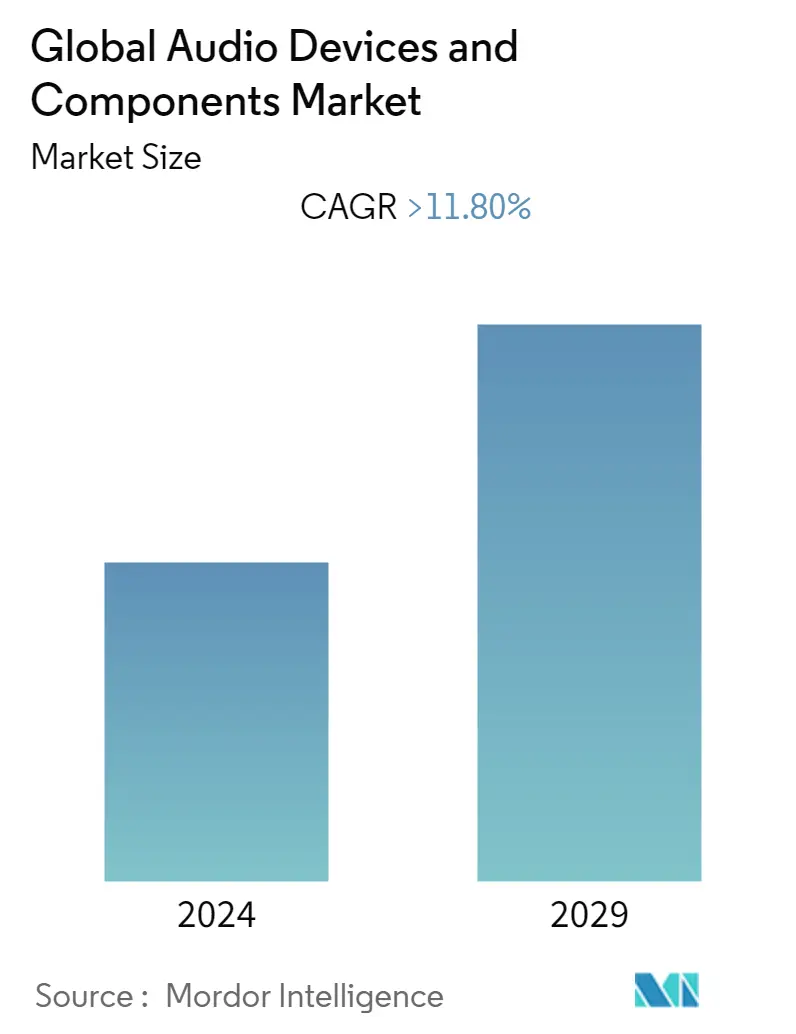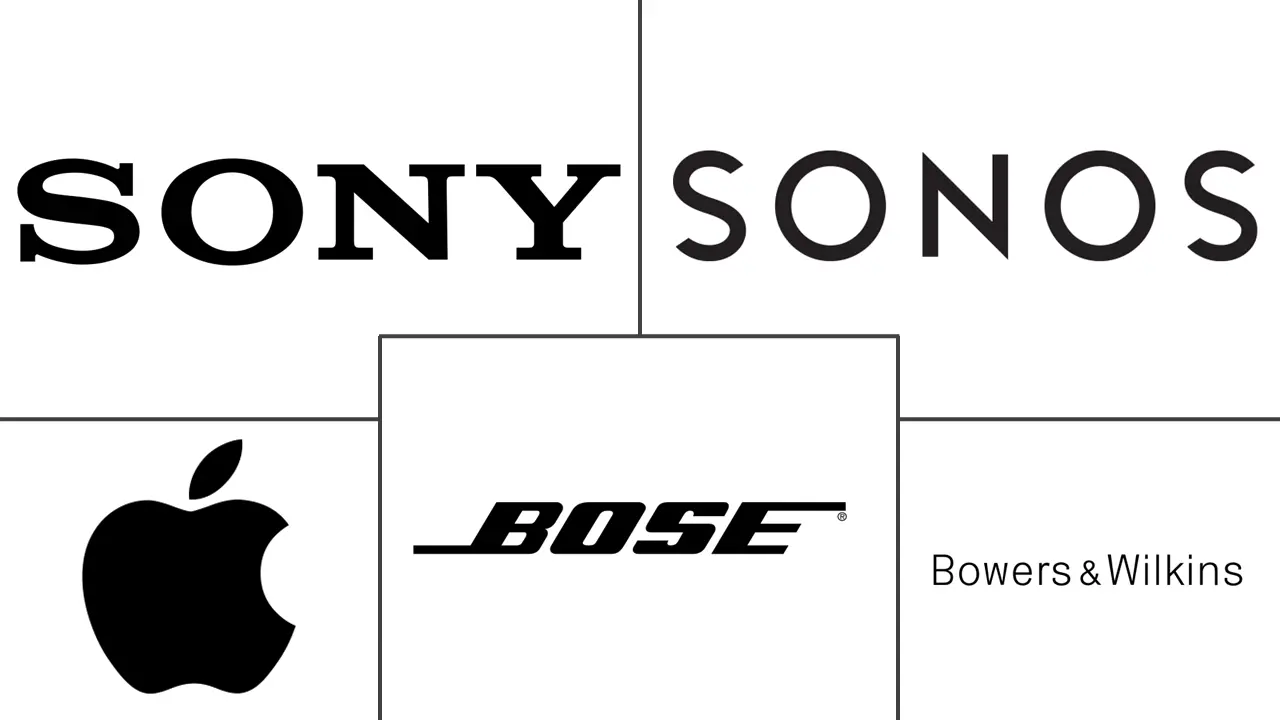Market Size of Global Audio Devices and Components Industry

| Study Period | 2019 - 2029 |
| Base Year For Estimation | 2023 |
| CAGR | 11.80 % |
| Fastest Growing Market | Asia-Pacific |
| Largest Market | North America |
| Market Concentration | Low |
Major Players
*Disclaimer: Major Players sorted in no particular order |
Audio Devices & Components Market Analysis
The Global Audio Devices and Components Market is expected to register a CAGR of 11.8% during the forecast period (2022-2027). The market is growing because of the incorporation of voice assistant technology and the availability of a wide range of products at competitive pricing. The advancements in artificial intelligence (AI), 5G networks, and the Internet of Things (IoT) have resulted in simple, stable, and dependable products.
- For instance, in September 2021, Bose introduced the Smart Soundbar 900 with Dolby Atmos, which comes with support for Google Assistant and Alexa voice control. The sounder also features WiFi and Bluetooth, a simple app for touch control, and is compatible with Spotify Connect and AirPlay 2.
- Also, the upsurge in demand for wireless systems is propelling the growth of the studied market. Most speaker systems have been developed to offer wireless options like Bluetooth and WiFi (or both) to cut down on the cables. This also increases WiFi connectivity, allowing users to sync services like voice control, Airplay, and Chromecast, and synchronize with other home speakers. Wireless smart speakers also allow the user to sync the speaker to the entire smart home. Smart speaker systems effortlessly link up with Amazon Alexa and other voice assistants in the house. Companies like Zebronics have invested in launching Juke Bar 9800 DWS Pro Dolby Atmos Soundbar with a wireless subwoofer. While, California-based Roku launched Roku TV Ready, an initiative that made connecting soundbars and receivers to its TVs easier. The company uses WiFi-based wireless audio technology with the Roku TV wireless speakers.
- Moreover, the increase in the consumption of media content from offline to online is propelling the consumption of subscription-based platforms, such as Netflix and Amazon Prime, thereby complementing the adoption of loudspeakers, such as soundbars and subwoofers. As most on-demand video content is watched over smart TVs, PCs, and mobile devices, sound bars enhance the experience of viewing such content.
- However, many wireless audio devices, including smart speakers, are constantly connected to the internet. These connected devices are in danger of cyber-attacks and data breaches that can create privacy issues and potentially lead to significant financial losses. For instance, a new study has revealed that attackers can hack modern audio gadgets to make loud sounds at high intensity, turning them into offensive cyber weapons. Such cybersecurity and privacy breach significantly affect the growth of the audio device equipment, thereby acting as a restraint for the market.
- Further, silicon chips are a primary component in many audio devices, including wireless speakers. Due to the supply chain disruptions caused by the covid-19 pandemic, along with the subsequent shutdown of many processor plants, the industry is suffering from a silicon chip shortage, which further restrains the growth of the market.
Audio Devices & Components Industry Segmentation
Audio device refers to devices that reproduce, record, or process sound. The scope of the study includes sales of various home audio equipment such as wireless speakers, audio components, Hi-Fi systems, and professional audio devices and audio components. For the study, various factors such as consumer spending, consumer preference trends, supply dynamics, the impact of COVID-19, and other macro-economic factors have been considered to arrive at the overall market projections.
| Home Audio | ||||
| A/V Receivers | ||||
| Hi-Fi Systems | ||||
| Soundbars | ||||
| ||||
| Dedicated Docks |
| Professional Audio | |
| Professional Audio | |
| Power Amplifiers | |
| Mixing Consoles | |
| Microphones | |
| Headphones |
| Audio Device Components | |
| MEMS Microphones | |
| Microspeakers | |
| Consumer Audio IC (Audio Codec) | |
| APU, SoC and DSP | |
| Audio Amplifiers |
Global Audio Devices and Components Market Size Summary
The Global Audio Devices and Components Market is experiencing robust growth, driven by the integration of voice assistant technology and the availability of a diverse range of products at competitive prices. The advancements in artificial intelligence, 5G networks, and the Internet of Things have led to the development of simple, stable, and reliable audio products. The increasing demand for wireless systems, such as Bluetooth and WiFi-enabled speakers, is further propelling market expansion. These wireless devices offer enhanced connectivity and convenience, allowing users to sync with smart home systems and enjoy seamless audio experiences. The shift from offline to online media consumption, with the rise of subscription-based platforms like Netflix and Amazon Prime, is also contributing to the growing adoption of audio devices like soundbars and subwoofers, which enhance the viewing experience on smart TVs and other devices.
Despite the positive growth trajectory, the market faces challenges such as cybersecurity risks associated with internet-connected devices and supply chain disruptions leading to a shortage of silicon chips, which are crucial for many audio devices. The North American market, in particular, is witnessing significant demand for wireless speakers and smart home audio systems, driven by the increasing popularity of infotainment devices and the need for portable, remote-accessible audio solutions. Major players like Bose, Sony, and Apple are investing heavily in wireless technology and smart home integration, creating new opportunities in the market. However, the fragmented nature of the market, characterized by rapid technological advancements and intense competition, poses challenges for companies aiming to maintain their market share and meet evolving consumer preferences.
Global Audio Devices and Components Market Size - Table of Contents
-
1. MARKET INSIGHTS
-
1.1 Market Overview
-
1.2 Industry Attractiveness - Porter's Five Forces Analysis
-
1.2.1 Bargaining Power of Suppliers
-
1.2.2 Bargaining Power of Buyers
-
1.2.3 Threat of New Entrants
-
1.2.4 Intensity of Competitive Rivalry
-
1.2.5 Threat of Substitutes
-
-
1.3 Technology Trends
-
1.4 Industry Stakeholder Analysis
-
1.5 Distribution Channel Analysis
-
1.6 Impact of COVID-19 on the Audio Market
-
1.7 Audio Industry Supply Chain Analysis
-
-
2. MARKET SEGMENTATION - BY PRODUCT TYPE
-
2.1 Home Audio
-
2.1.1 A/V Receivers
-
2.1.2 Hi-Fi Systems
-
2.1.3 Soundbars
-
2.1.4 Wireless Speakers
-
2.1.4.1 Bluetooth and/or Wi-Fi Enabled
-
2.1.4.2 Smart Speakers (with Virtual Assistant)
-
-
2.1.5 Dedicated Docks
-
-
2.2 Professional Audio
-
2.2.1 Professional Audio
-
2.2.2 Power Amplifiers
-
2.2.3 Mixing Consoles
-
2.2.4 Microphones
-
2.2.5 Headphones
-
-
2.3 Audio Device Components
-
2.3.1 MEMS Microphones
-
2.3.2 Microspeakers
-
2.3.3 Consumer Audio IC (Audio Codec)
-
2.3.4 APU, SoC and DSP
-
2.3.5 Audio Amplifiers
-
-
Global Audio Devices and Components Market Size FAQs
What is the current Global Audio Devices and Components Market size?
The Global Audio Devices and Components Market is projected to register a CAGR of greater than 11.80% during the forecast period (2024-2029)
Who are the key players in Global Audio Devices and Components Market?
Sony Corporation, Bose Corporation, Apple Inc., Sonos Inc and Bowers & Wilkins. are the major companies operating in the Global Audio Devices and Components Market.

